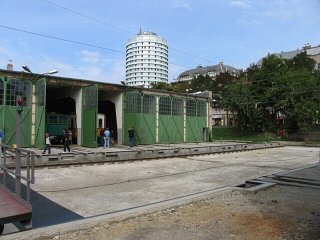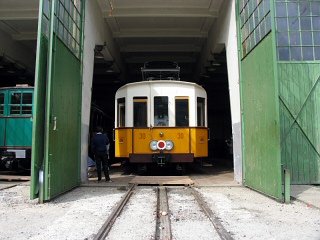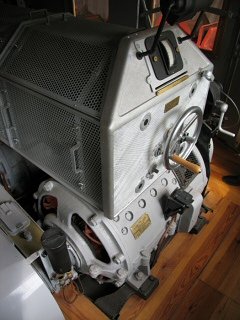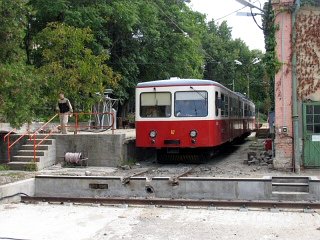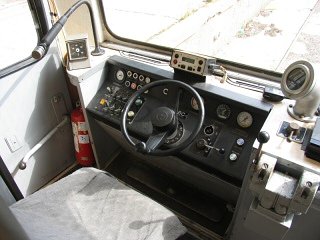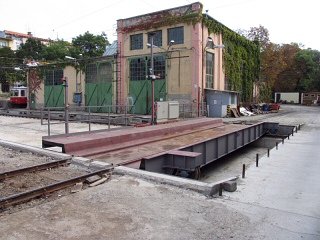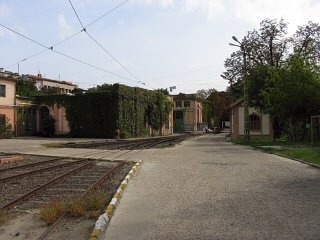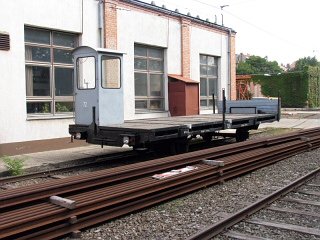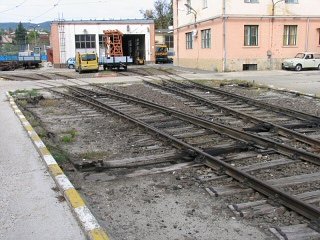budapest
other hungarian
close-up
lost rails
other countries
The depot of the Városmajor - Széchenyi-hegy cogwheel (rack) railway
Even if it's technically incompatible with the tramway system today, the Budapest cog-wheel railway still falls under the control of the tramway branch of the BKV. That's the result of a long evolution of this transportation mean, which started in 1874, when Nikolaus Riggenbach's company (yes, that Riggenbach) has launched a steam-powered cogwheel railway on the Buda hillsides. The line was extended from Svábhegy to Széchenyi-hegy in 1890. The 3.7-kilometer route was transferred to the municipal transportation company BSzKRt in 1926. They soon started to upgrade the line, by electrifying it with the urban tramway's power system (same voltage, same overhead wire system, even same livery), by adding new passing loops and replacing the old trackage, and by providing better schedules. The modernised operation started in 1929. After WW2 the line got more and more worn, and liquidation became a possibility by the turn of the sixties/seventies. But it did not got to that point: "the Cog" was completely rebuilt in 1973 to celebrate the 100th anniversary of the merger of Buda, Pest and Óbuda into Budapest. Quite unfortunate was however that they not only changed the cog-rail system (from Riggenbach to Strub), but also the voltage (from 550/600V to 1500V), because that was the voltage which the new vehicles - offered by SGP and BBC of Austria - were using. This detached the cogwheel railway from the tramway's power system, and also made any kind of heritage vehicle running impossible.
Thus, the Budapest Cogwheel Railway is now an "island operation", which is bad for the business, but oddly enought adds a certain appeal for tram/train fans. The depot of the line is located at the lower terminus in Városmajor, right next to the tracks of tram lines 18, 56 and 59. Usually it's not possible to go in there, but they opened the doors during the 2007 Days of European Cultural Heritage, and I was there to take a few pictures.
The depot is pretty much as it was built for the 1929 electrification. The core of the site is formed by two halls approachable for vehicles via a traverser table. On these pictures we can spot a green passenger car from 1874, and the first locomotive+trailer set of the electric operation. While the passenger car can be rented (it can be towed by a normal car of the railway), the electric train (built by SLM of Winthertur and Ganz of Budapest) is inoperable due to the technical differences mentioned in the introduction of this page.
To the left: the controller of the SLM/Ganz electric loco, with one of the traction motors beneath. To the right: interior of the passenger (trailer) car of the electric set.
A current train of the railway, built by SGP and BBC, and one of the driver's cabs.
The traverser table (left-hand side photo) was replaced very recently: the old one was just put down at the end of the yard (photo on the right-hand side).
This place is sooo peaceful in contrast to some other tram depots! By the way, the overhead wire inside the depot is electrified at 600V, so these tracks can be used by normal trams, too - although you don't often see this nowadays. On the right-hand side: one of the flat waggons of the railway, used for internal transports. It was converted out of a 1875 passenger car.
As I said, trams can use these tracks, and the cogwheel vehicles also use them without rack rails, but since the cog-wheel hangs below the rail surface, the switches are a bit more complicated than normal tram switches (left-hand side). On the right-hand side: this is where the cogwheel vehicles change from adhesional operation inside the depot to cogwheel operation on the line. And this is also where this page ends :)
Back to the top Back to the main page
